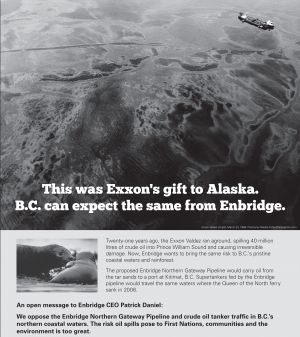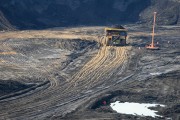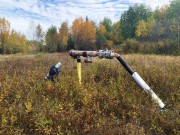I've worked at Pembina for four years now — long enough to know that this isn't the type of organization that jumps on bandwagons. So, it was with more than a little consideration that we added our name to an ad printed in the Globe and Mail on Tuesday.
On the 21st anniversary of the Exxon Valdez oil spill, dozens of First Nations, along with environmental organizations and prominent individuals, joined forces to draw attention to the risk of an oil spill in B.C.'s coastal waters if the Enbridge Northern Gateway oilsands pipeline proceeds.
 While the ad focuses on the fact that, if approved, this pipeline will allow crude oil tankers in B.C. waters, it's just skimming the surface of environmental concerns with this project.
While the ad focuses on the fact that, if approved, this pipeline will allow crude oil tankers in B.C. waters, it's just skimming the surface of environmental concerns with this project.
This risk — combined with three more key concerns — was enough for us to support the ad's message, directed to Enbridge CEO Patrick Daniel: "We oppose the Enbridge Northern Gateway Pipeline and crude oil tanker traffic in B.C.'s northern coastal waters. The risk oil spills pose to First Nations, communities and the environment is too great."
Our second concern is that the proposed pipeline will carry bitumen from Alberta's oilsands to new markets, enabling a 30 per cent increase in oilsands production. The environmental issues associated with oilsands are deeply problematic and precious little has been done to remedy existing concerns, much less to allow expansions in oilsands activity. Further, the federal government has refused to include these upstream impacts in the review process for the pipeline, despite direct requests by Pembina and many other environmental and community organizations.
Third, the pipeline will follow a treacherous mountain route, crossing important salmon habitat in the process. It's not a question of if a pipeline failure will happen, it's a question of when and where — and how badly it will impact the environment. According to a National Energy Board report, there is an average of one rupture every 16 years for every 1,000 kilometres of pipeline in Canada. It is unlikely that the Enbridge oilsands pipeline would be immune.
Considering the Enbridge oilsands pipeline would carry 700,000 barrels of petroleum products each day, across a landscape littered with avalanches and landslides, while crossing 1,000 rivers and streams in B.C., the consequences of any leak or rupture could be catastrophic.
Fourth, salmon habitat isn't all the pipeline would traverse. It also crosses through the traditional territories of more than 50 First Nations communities, more than half of which indicate direct opposition to the project in the Pipe Up Against Enbridge ad campaign.
That's four strikes, Enbridge. Forging ahead on a project when First Nations stand united against supertankers travelling through their pristine coastal inlets is bad enough, but when you add in the other problems with this plan, it becomes crystal clear that the Northern Gateway Pipeline is a murky proposition and should be dead in the water.









